Anand Reviews the Apple iPhone 3G
by Anand Lal Shimpi on July 16, 2008 8:00 PM EST- Posted in
- Smartphones
- Mobile
MobileMe
It’s only been in the past couple of years that I started to understand exactly what it is I do for a living. I’m a writer, woo! I happen to write a column for CPU Magazine every month, I’m constrained for space there since it’s print (750 words or less, or your pizza is free). Last month I wrote an article titled Apple Takes on...Google?
The article talked about Apple’s foray into the world of web applications - it was sort of prep-work for today’s iPhone 3G review. You see, alongside the firmware 2.0 and iPhone 3G announcements, Apple also introduced something called MobileMe at this year’s WWDC.
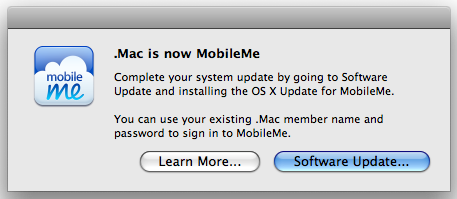
.Mac is now MobileMe
MobileMe is Apple’s own web-based application suite, featuring an email client, address book, calendar application and support for file and photo sharing. In essence, this is Apple’s answer to Google’s online applications - except you have to pay for them.
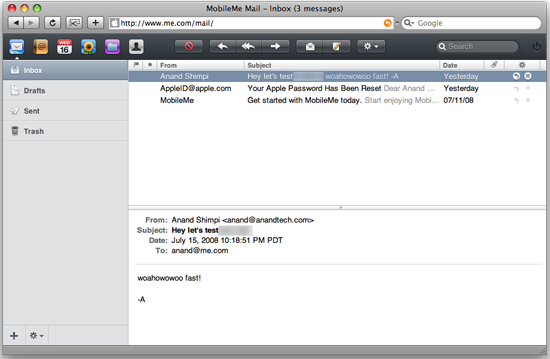
MobileMe Push Email
A MobileMe account costs $99 a year, but what that gives you is the ability to sync your email, address book, calendar, files and photos across any computer (Mac or PC) and iPhone, in real time. You also get 10GB of storage, and the big kicker - push email support.
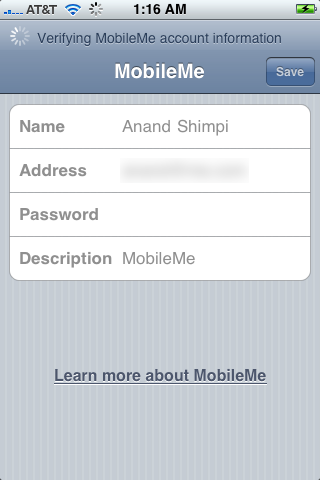
The concept of push email is simple: when an email is sent to your push-enabled email account, the notification is sent directly to your device (computer or iPhone) and you receive the email instantaneously. Normally, the greatest frequency you can check your email account on an iPhone is every 15 minutes, which can be a problem if you depend on responding to emails as soon as you get them.

Push email on the iPhone, without Exchange. Awesome.
I do sorely miss push email from my Blackberry days, MobileMe gave me my first taste of that in over a year. It took less than 10 seconds from the time I sent an email to my @me.com account to when I got it on the iPhone, which is just sweet.
The push email support for MobileMe alone is almost reason enough to cough up the $99 per year, but when you realize that works out to $8.25 per month just for email you really have to ask yourself whether the push email is really worth it. Honestly what needs to happen is push email support from Google, that would make the iPhone a real alternative to the Blackberry from a consumer standpoint. Granted enterprise users now have push email support with Exchange, but for the rest of the world it’d be nice if there was a free alternative.
MobileMe is a nice online application suite and is incredibly easy to setup, allowing all of your Macs, PCs and iPhone to remain in sync but honestly for me it just doesn’t make sense. My iPhone and main machine are always synced, and it doesn’t really matter that my notebook isn’t since I have my synced iPhone with me wherever I go. The $99/year MobileMe account would be nice, but it’s far from a necessity.
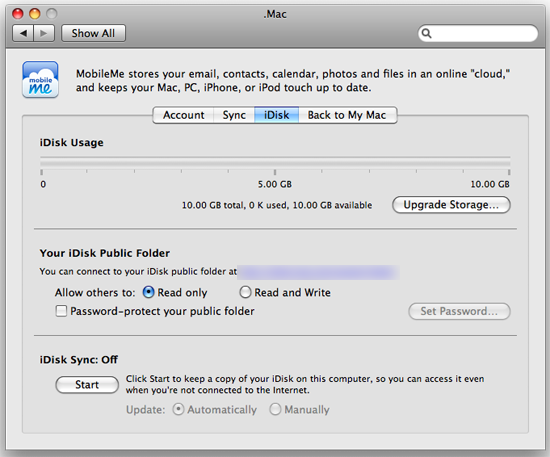
The ability to keep tons of files synced between all of my machines is also a plus, but honestly my upload speeds aren’t fast enough to make this terribly practical for things like videos and music. For small files, I don’t want to have to manually copy them to my iDisk, I want to mirror my Documents folder by default.
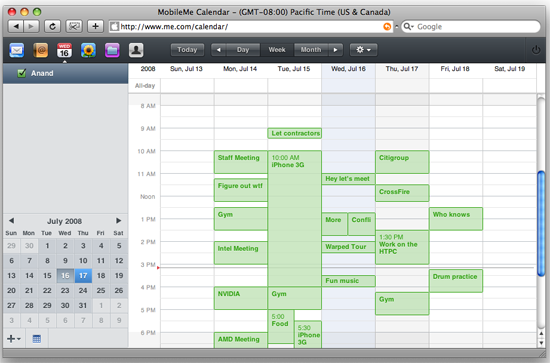
Yes, this is a web-application, it looks very good but unfortunately I've had connectivity issues over the past few days. It's not as speedy as I'd want for $99 a year.
MobileMe is a great way of getting a glimpse at the totally networked future we’re not too far away from, there are just too many shortcomings for me to justify giving Apple another $100 every year on top of the annual iPhone upgrades I seem to be doing. Give me Push Gmail and I’ll be set.
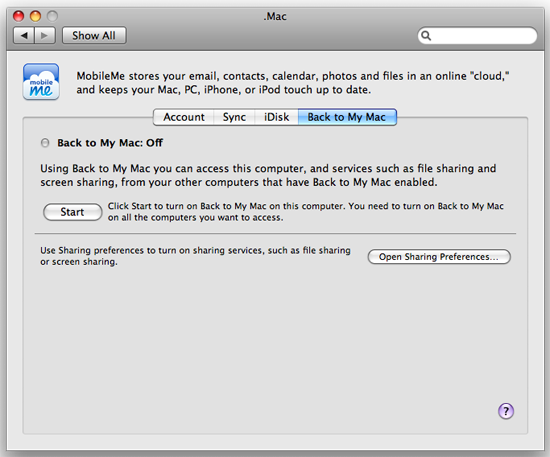
Alternatively, if Apple provided web-versions of Pages, Numbers and Keynote, as well as real time document syncing between all of them (ala Google Docs), then the $99 fee starts becoming more attractive.










55 Comments
View All Comments
buckdutter - Friday, August 22, 2008 - link
AT&T's coverage could indeed be better, but then again they are still rebuilding from when they decided to switch from TDMA to GSM, instead of following the natural path to CDMA, which Verizon, Sprint, and Alltel (soon to be Verizon) use, as well as many more localized carriers. The problem with CDMA is that it is going nowhere. The majority of the world is GSM, and CDMA is becoming more and more marginalized, in fact in the next 4 or 5 years CDMA will be practically phased out in the US. Verizon (and Alltel) will be switching to LTE, a GSM based technology which will be a rough transition - either resulting in sacrificed coverage, or more expensive devices (like Verizons expensive "world edition phones") that will run on both their networks. Either way, they will be doing what AT&T (Cingular, whatever) did 4 or 5 years ago, and much later in the game.Meanwhile AT&T will make a natural transition from their 3G, which is in all fairness not nearly as widespread as EVDO at the moment, to LTE. Sprint will be going WiMax. Not one major carrier in the US or abroad has made a commitment to the future of CDMA. Verizon has held on to EVDO as long as it could, and has prolonged having to switch, but they are beginning to hit the limitations of EVDO, meanwhile 3G is just getting started, with AT&T planning to follow suit of carriers abroad and boost the speeds to around 20mbps in mid-2009. EVDO will be topping out around 3.2 at most, if even that.
While having used all the services I strongly disagree with saying that Sprint or T-Mobile even come close to AT&T for coverage, it is largely regional subjective, and is really not fair to work in experiences in one localized area into the review for the phone. Like them or hate them, AT&T recognized early that GSM was the roadmap to go. Like it or hate it, blame Verizon for delaying the inevitable for so long...it makes no sense for Apple to make a CDMA phone when it is so limited in implementation globally. Because of that decision they are the most widespread GSM provider in the US (the US was a little late in getting into the GSM game).
In the end, AT&T may have a lot of ground to cover, but we should be excited what at least one U.S. carrier took the leap and is building out a GSM network in the states, even though it meant making the sacrifice of less coverage in rural areas as they build the new network out. It will be interesting to see how Verizon copes with having to change over.
Hrel - Tuesday, August 12, 2008 - link
Over 2 years the new iphone plane costs an extra 60 bucks, but the upfront cost is 300 dollars less. The iphone 3G is less expensive in every way; even with the incremental increase in contract cost. I'm confused that I need to point this out considering you say it in your article then contradict yourself by saying the old plan and phone was less expensive. Total cost over two years the new one is 240 dollars less.maxnix - Thursday, July 31, 2008 - link
With no user replaceable battery, it is a toy, not a reliable business device.It seems to me that 90% of the users I see are fiddling about on it with their fingers and not even 10% use Bluetooth. Are there still no voice driven commands? That's how I use my phone.
Seems like a great device for someone who wants to make calls on their iPod when they are not listening to a lossy audio source.
Jobs is the new PT Barnum in that he fully exploits the "A sucker's born every minute..." credo. The world is full of lemmings.
maxnix - Thursday, July 31, 2008 - link
Welcome fanboys to AT&T's limited 3G. The rest of the world has been there for 5 years.Lezmaka - Monday, July 21, 2008 - link
I think there's a fairly obvious (to me anyway) reason why the talk time measured is almost half the time the specs state, beyond the best case scenario stuff.In most conversations, there's a significant amount of dead air. Even if it's only 1/10 - 1/4 of a second at a time, over the course of several hours, that will add up. But with most music, there's almost no dead air. Even when the person isn't saying something, there's at least some sound being generated. Detecting that dead air and not transmitting would probably be the best for battery life, but even if it continually transmits, the compression would reduce the amount of data transmitted to almost nothing.
I would guess that choosing an audio source that more closely matches an actual conversation would provide a somewhat more accurate test result. But I'm not expert, so what the hell do I know?
Giacomo - Monday, July 21, 2008 - link
Ehm... No man, there's no way this could influence battery life. No matter how intense is the information in the call, most of the energy drain is due to the "line" itself... Keeping the full-duplex conversation online.Everything else left to the battery is the loudspkeaker consumption... But it's a ridicolous amount, you won't be able to measure its impact.
Giacomo
donhoffman - Tuesday, July 29, 2008 - link
Actually the original commenter on this was correct. This is a time-honored technique for getting more battery life out of cell phones. Channel allocation for voice calls is done at call setup. A continuous data stream is not needed to keep up the "line". If either end of the call has nothing to send, it does not need to transmit, saving significant power. The technique used in this article probably does underestimate the battery life. Not by 100%, but maybe 20-30%. Transmit power is much larger than audio power. That is why you get 24 hours listening to music on the iPod side, but only 5 or so hours doing cellular phone calls.nichomach - Sunday, July 20, 2008 - link
Not wishing to get into whether the new iPhone is all that, I'd note that the enforced PIN code when using Exchange is usually a policy setting defined in Exchange, and there's a choice about enabling it. That choice'll be made by your Exchange admin(s). If they enable it - personally, I do - then I'd expect it to be enforced on any device that claims to support Activesync. One of my arguments with Nokia's Mail for Exchange client, for instance, is that it doesn't (or didn't) properly support policies like that; that the iPhone does makes it a viable choice if I end up with a director demanding one. If you're using your phone in a corporate environment, then you may be sending and receiving confidential stuff. Enforcing a PIN and supporting remote wipe properly is the sine qua non as far as I'm concerned.Schugy - Sunday, July 20, 2008 - link
Openmoko will have the best 3rd party support while Nokia and Google (Maemo / Android) have their own ressources. But regarding their openness they are evil. The FIC Freerunner is a nice phone but the Openmoko project still has to develop a lot.On the other hand I think that a Open Pandora handheld with a USB HSDPA modem (maybe builtin in future revisions) is a lot more usable and even has game controls. Telephony and navigation could be done via a bt headset+voip and gps receiver.
All the platforms will feature ports of killer apps like pidgin IM, scummvm, evolution e-mail and lots more. Ports of gnash, the GNU flash player, are possible too but I would suggest to get rid of these stupid and annoying banner ad players. A nice stream or download link for mp4-files will make your full featured (fullscreen / post processing filters) mplayer happy.
cleviticus - Saturday, July 19, 2008 - link
A basic one-line plan with Cingular (I know they go by AT&T now)without ANY extra features runs you $45/month and that is with just enough minutes to tell people that you'll call them back after nine. Unlimited internet and data runs $45, last I checked, and that somehow doesn't cover much texting, something I do a lot of. Texting is another $10. So to get service and data BEFORE tax you spend $90. My provider offers unlimited voice/data/text/GPS/e-mail for $100 with coverage that exceeds AT&T's.That fact alone is enough to keep me away from the iphone for good. I admit that the interface is unbeatable but the functionality of the phone is not. That being said I don't think it deserves as much attention as it receives. Also coverage varies drastically from city to city. In NY my phone works great but in Vegas it blows. In Chicago I'm golden but anywhere between Arkansas and Virginia- forget about it. I used cingular for two years and their coverage was only good in large metropolitan areas. As soon as I got out of the inner city my reception was weak and I couldn't even text. I think they are a horrible company but since they bought up most of the old bell empire- they're here to stay.